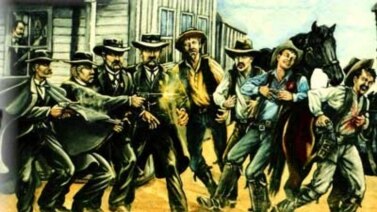VOICE ONE:
Welcome to THIS IS AMERICA in VOA Special English. I'm Steve Ember.
VOICE TWO:
And I'm Barbara Klein. This week on our program, we tell you about some fiftieth anniversaries that are being observed this year.
(MUSIC)
VOICE ONE:
In nineteen fifty-nine, an unusual art museum opened in New York City. What was unusual was not so much the art but the museum.
Most museums lead visitors through a series of rooms. But the Guggenheim Museum is round. Spaces flow smoothly from one area to another. In place of steps, a ramp goes round and round past the art on the different levels. The center of the museum is open, so people can look up toward the roof or down toward the ground floor.
VOICE TWO:
The Solomon R. Guggenheim Museum was designed by Frank Lloyd Wright. He died six months before it opened. Not everyone liked the unusual design. But it produced one of the most recognizable museums in the world.
A fiftieth anniversary exhibition will honor the architect and his work. From May fifteenth till August twenty-third, the Guggenheim in New York will present "Frank Lloyd Wright: From Within Outward."
VOICE ONE:
The exhibition will show sixty-four projects that he designed, including homes, public buildings and religious spaces. More than two hundred of his original drawings will be shown. The Guggenheim says the aim is to celebrate the basic idea behind Wright's architecture -- the sense of freedom in interior space.
(MUSIC)
VOICE TWO:
The Guggenheim opened in October of nineteen fifty-nine. That same month, the Voice of America began to broadcast special programs for English learners. Some language experts thought the idea would fail. But millions of listeners welcomed Special English.
Special English is read one-third slower than VOA's other English programs. The slower speed is combined with an extra effort to make the writing easy to understand.
Most of the words come from a vocabulary list that gets updated about every ten years. It began with one thousand words. Today it has about five hundred more. But writers can use any other words they need to report a story if the meaning is clear.
VOA Special English is an example of a controlled language. Another example is called Simplified Technical English. This language was developed to make it easier to understand and translate documents used at aircraft repair centers around the world.
VOICE ONE:
Special English is popular because it helps people learn American English while they learn about world news, science, American life and other subjects. The first broadcast was ten minutes of news to Europe, Africa and the Middle East.
There was no special announcement. Announcer Paul Parks just said, "Here is the news in Special English." Feature programs were added later, starting with Special English versions of short stories by famous writers. That program, AMERICAN STORIES, can be heard each Saturday.
VOICE TWO:
Today, Special English writers do a lot more original reporting and the programs are more lively. But one thing has never changed. Special English has a loyal following -- in homes, cars and classrooms throughout the world.
Some people are second-generation fans whose own children are now growing up with Special English. And not just on radio, but also TV and the Web: voaspecialenglish.com is one of VOA's most heavily visited sites.
Visitors can read and listen to programs, write comments, find shows they missed and sign up to receive programs by weekly e-mail. They can download MP3s and podcasts and access the Word Book. And they can watch videos in Special English. There is also voaspecialenglish.com/mobile. And Special English is expanding into social media. The goal, as always, is to follow English learners wherever their interests take them.
(MUSIC)
VOICE ONE:
This year is the fiftieth birthday of Barbie. The doll first appeared at the toy fair in New York on March ninth, nineteen fifty-nine.
Its creator was Ruth Handler, an American businesswoman. She and her husband Elliott along with Harold "Matt" Matson started the toy company Mattel. She named the new doll after their daughter Barbara. She based the design on a German doll named Bild Lilli.
The first Barbie wore a black and white swimsuit and had her hair in a ponytail. She looked and seemed very grown up. But any concerns that parents would not want to buy it for little girls were soon proved wrong.
Mattel sold three hundred thousand Barbie dolls in the first year at a price of three dollars. Today, a fifty-year-old Barbie in good condition might cost more than twenty-seven thousand dollars.
VOICE TWO:
Barbies have represented fifty different nationalities and are sold in one hundred fifty countries. Mattel says ninety percent of girls in the United States between the ages of three and ten own at least one Barbie doll. It says girls between the ages of three and six own an average of about twelve.
Barbie has faced recent competition from Bratz dolls. Barbie has also faced her share of critics.
A well-known example was when women's education groups objected to a talking Barbie that declared, among other things, "Math class is tough!" Mattel agreed to change it. That was back in nineteen ninety-two, the same year as the first Barbie for President doll. The dolls, though designed in California, were produced in China. Because of that, some people joked that Barbie could not legally become president of the United States.
Saudi Arabia has banned Barbie dolls. And a lawmaker in the American state of West Virginia would like to do the same. Last month, he proposed banning sales of Barbie and other dolls that influence girls to put too much importance on physical beauty.
Some people say Barbie is an unhealthy role model for young girls. Robin Gerber disagrees. She wrote a book about Barbie. She points out dolls like scientist Barbie and race car driver Barbie. She says people who criticize Barbie should tell girls the story of the businesswoman who created her. She says Ruth Handler wanted the dolls to help girls think about what they wanted to do with their lives.
(MUSIC: "That'll Be The Day")
VOICE ONE:
Singer Buddy Holly died in February of nineteen fifty-nine. He was just twenty-two, but he was already being called a musical genius.
Buddy Holly was killed in the crash of a small plane while on a singing tour in the Midwest. The crash also took the lives of the pilot and two other singers -- J.P. Richardson, known as the Big Bopper, and Ritchie Valens. He had a hit with this song, "La Bamba."
(MUSIC)
VOICE TWO:
The plane went down after the singers had performed at the Surf Ballroom in the small town of Clear Lake, Iowa.
This year, some of those who performed with them that night gathered at the Surf to remember. The gathering, held over several days, was called "Fifty Winters Later." It included educational programs, dance lessons, speeches and theatrical performances. It also included a ceremony to declare the Surf Ballroom a rock and roll landmark. The events were organized by the Surf Ballroom and the Rock and Roll Hall of Fame.
Guests included Buddy Holly's wife, Ritchie Valens' brothers and sisters and the Big Bopper's son.
VOICE ONE:
The day of the plane crash -- February third -- is known in rock and roll history as "the day the music died." We end with a song inspired by that sad day. Here is Don McLean with his number one hit from nineteen seventy-two, "American Pie."
(MUSIC)
VOICE TWO:
Our program was written by Nancy Steinbach and produced by Caty Weaver. I'm Barbara Klein.
VOICE ONE:
And I'm Steve Ember. Join us again next week for THIS IS AMERICA in VOA Special English.
VOA Special English was first broadcast October 19, 1959.



